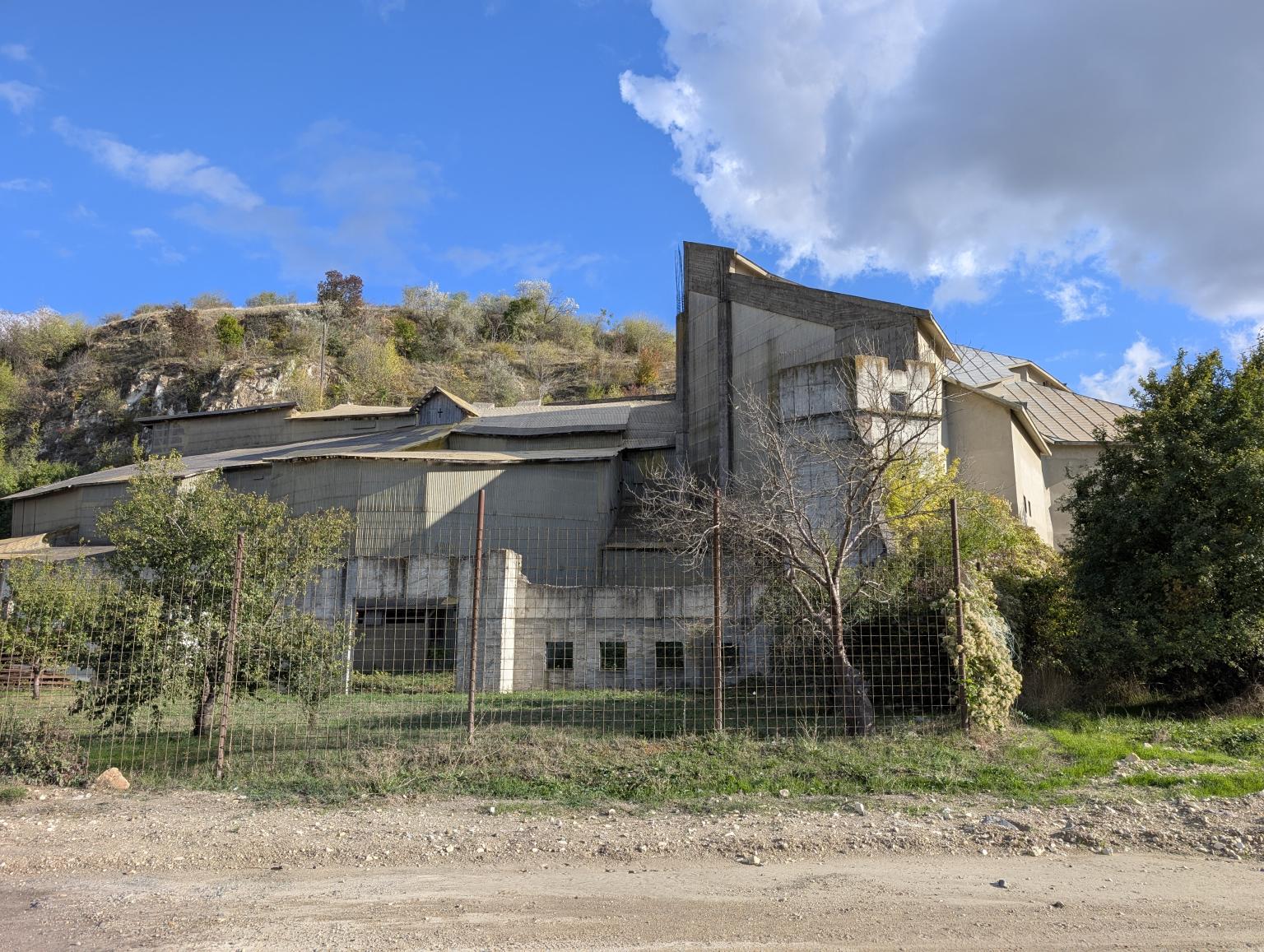
cent. X - XI, Epoca medievaltimpurie
From the center of the commune, a road goes up to the place where the archaeological complex of Basarabi is found, an interesting tourist point from the period of early feudalism. In the summer of 1957, workers from the current chalk quarry discovered a small church dug in the white massif of the Tibisir hill.
Later, five more cave churches, several ruins of dwellings and nine tombs were found, along with numerous tools.
The modest dwellings, either buried in the ground or raised on the surface of the land and usually grouped near the restored walls of the Romano-Byzantine fortresses, are the most widespread constructions from the X-XIII centuries discovered so far in Dobrogea through archaeological research.
Six small rock churches, accompanied by rooms and funerary galleries, all carved in the chalk quarry at Basarabi, together with the ruins of two wall churches, one found at Dinogetia-Garvăn and the other at Niculițel, are currently the most significant monuments that gives us an image of the religious architecture from the 10th-13th centuries in Dobrogea. These discoveries demonstrate that, like other regions of the Balkan Peninsula, small churches or chapels, with a rectangular, cruciform or trefoil-shaped plan, took the place of the large basilicas of the Roman-Byzantine era.
The oldest constructions, dating from the end of the 10th century and the beginning of the 11th century, and at the same time the most original in Romania, are the little churches or funerary chapels carved in the chalk massif from Basarabi. One of these churches, located in the south-west part of the cave complex, the most remarkable in terms of architecture, distribution and interior ornamentation, has unfortunately been largely destroyed. Immediately to the east of this, connected to each other by three openings, is another room, almost entirely preserved. It has an irregular quadrangle plan, with each side about 3 meters long and an average height of 2.20 meters.
On the eastern side is the altar, in an arched niche at the top, flanked by two other smaller niches. The altar was separated from the rest of the room by a wall or balustrade carved into the chalk massif, of which only the lower part has been preserved. An entrance is excavated in the northern wall, which continues with five slightly vaulted galleries, measuring between 2.50 and 7 meters long, 0.50 and 0.90 meters wide and 1 and 1.30 meters high, communicating with each other. They served as a burial place. On the left side of the entrance is carved the figure of a saint in his nimbus, together with crosses and a short inscription in runic characters. On the south and west walls are carved other crosses, signs and two fantastic figures of dragons, made up of braids. It is assumed that the entire interior was painted, and carved or incised figures, crosses and inscriptions were more evident against a dark background. Traces of red paint are still visible here and there.
The four other churches excavated in the compact chalk ground at Murfatlar are grouped on the eastern side and all have a simple rectangular plan, each having an apse to the east or southeast, but the dimensions and interior heights vary from one monument to another. On their walls are depicted crosses, various signs, drawings and inscriptions written in runic, Greek or Glagolitic characters. It is remarkable that on the walls of one of these churches there are drawings that are not associated with the sacred nature of the place of worship. For example, a "target" is represented on the wall of the altar, and below it are two figures of horses, of which the front one is standing. On the wall of the nave is depicted another "target", to the left of which are represented two horses, each with a rider.
A few meters behind the chalk ground and about 6 meters west of the entrance to the first of these four small churches, or 5 meters below the level of its threshold, two burial chambers were found. Various figures, scenes and graffiti are drawn on the walls, including multiple crosses, schematic drawings of animals (horses, dogs, birds), fantastic images of dragons, geometric figures and inscriptions written in runic characters.
Even if the research on the rock monuments at Basarabi is not completed, some preliminary conclusions can still be drawn. It is clear that in the last decades of the 10th century and at the beginning of the following century, during the reign of Emperor Basil II the Bulgarocton, there was a large quarry for the exploitation of the white massif, in the area where the chalk quarry is now. This quarry was intended to provide stone for the construction of the "stone wave" nearby, under the leadership of the Byzantine state, with local employees and other migrant populations in Dobrogea. There is a close connection between the 10th-11th century chalk quarry and the carved monuments in its area, such as small churches, vaults and living galleries.
The same workers who exploited the quarry also carved the monuments, using the same tools, of which six stone hammers and an iron ax were discovered in the quarry. Quarry workers intentionally bare certain portions of the massif to carve small churches, vaults, galleries and simple tombs. The way the quarry was exploited and the characteristics of a series of artistic elements specific to the Paleo-Christian period, such as the basilica plan of the small churches, the representation of the fish, the shape of the cross, the sculpture technique and the construction of the tombs, indicate the existence of an older local population that preserved and transmitted these practices to the new come in contact with.
The structure and internal organization of some of the churches carved into the chalk massif at Basarabi reveal skilled craftsmen who have a solid knowledge of Byzantine monuments of the same period (semi-cylindrical domes, Byzantine "cross" domes). Various other elements of architecture, sculpture or simple incised ornament also indicate a strong influence of Byzantine art. Among them, it is worth mentioning some representations of saints dressed in Byzantine costumes, as well as the "Nativity" scene, the oldest and, at the same time, the simplest iconographic representation of this scene known so far in Romania, together with a whole series of crosses which demonstrates the same source of inspiration.
A distinct category of representations on the walls of the Basarabi monuments is represented by the large number of horse figures. In a few places figures of horsemen also appear. Representations of horses vary in size and position: standing, head forward or backward, galloping, standing on two legs, etc. The prevalence of horse depictions primarily suggests the existence of a steppe population, with its specific culture and customs, converted to Christianity not long before the dates of the monuments. The presence of horse figures on the walls of places of worship and in burial chambers can be explained by the persistence of old pagan customs, possibly with cultic or ritual connotations (horse burial).
Another category of representations, such as the fantastic images of dragons or dragons, whose bodies are made up of braids and repetitive figures, indicate the influence or even the presence of a population of Nordic origin. The same northern provenance is also evidenced in the depictions of the ship or the labyrinth. These figures could be associated with the Viking world, being linked to the trade route that connected the various Scandinavian settlements with Constantinople, crossing the Baltic Sea through the island of Gotland, continuing on the Neva to Lake Ladoga, and thence south to Novgorod, the most important center of old Russia, after Kiev. Further south, the route continued up the Dnieper, reaching Kiev, and, exiting the Black Sea, followed its western coast to the Bosphorus and finally to Constantinople.
A special interest is given to the runic graphs, the number of which exceeds 60 copies. Deciphering them is considered an extremely difficult problem by specialists, because the language in which they are written is not known.
Starting from the information provided by the writer Walafrid Strabo about the existence, in the first half of the 9th century, of some remnants of the Christian Goths from the 4th century in the current territory of Dobrogea, who still performed church services in the Gothic language, it has been suggested that the runes at Basarabi may be of Gothic origin.
Source: The Romanian Black Sea Coast (Ministry of Tourism, 1976)

4 out of 5 stars
based on 0 reviews
If you’ve visited this place, share your thoughts with others
write review